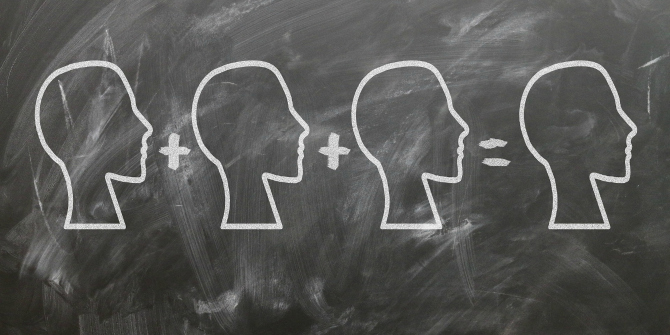Accessibility checklists are increasingly becoming offered as ways to improve inclusivity in Higher Education. However, they rely on the presumption that those delivering education and thus using them have no accessibility needs of their own. Moreover, in seeking to codify what counts as inclusivity, many students’ requirements get overlooked. In this post, Dr Kelsie Acton and Dr Dieuwertje Dyi Huijg outline the problems with accessibility checklists and propose a praxis of ‘relaxed pedagogy’ in their place.
Higher education institutions (HEIs) have a history of inaccessibility – marginalising, among others, disabled and neurodivergent (people whose bodies and minds process and experience stimuli and information differently from what is deemed ‘(neuro)typical’ in society) students and teachers.
A specific manifestation of inaccessibility has been the unwillingness of HEIs to offer disabled students digital access to learning, whether through distance learning or using digital devices in the classroom. As the world has rapidly shifted in 2020 due to the pandemic, HEIs have taken much of teaching online. Digital teaching, however, does not guarantee accessibility. To welcome a wider range of students and teachers and to make our teaching and learning more welcoming, we advocate for using this moment as an opportunity to radically shift how we think and go about creating more accessible classroom environments.
The problem with accessibility checklists
While we favour accessibility, we argue against ‘accessibility checklists’. Accessibility checklists seek to provide a tick list for practitioners to complete before delivering sessions. Sure, such checklists have an allure. After all, they are concrete ways to start learning about and increasing access. Just completing a checklist, however, “is likely to have little impact on the development of in-house practices.” Checklists themselves, then, can become a barrier to creating radical access – and we are not even referring here to (the irony of) the inaccessible accessibility checklist – unless they are understood as a starting place for an ever evolving, relational and contextual approach to access.
Universities often rely on checklists for accessibility, in particular on checklists drawing on Universal Design for Learning (UDL) as the go-to method for accessible learning. Although UDL is not intended as a checklist – after all, it seeks to be a “framework to improve and optimize teaching and learning for all people” – HEIs often employ UDL by placing an accessibility checklist somewhere on their website (see this example). When a university publishes an accessibility checklist on their website they can actually remove the possibility of a meaningful dialogue between student and teacher about access beyond UDL. This practice furthermore ignores off-checklist situations. For instance, UDL checklists call for multi-sensory engagement, meaning that both visual and auditory material, modes of teaching, and evaluation need to be offered; however, since not everyone can function multi-sensorily, this approach lacks situational nuance. Some students have needs that are not supported by the specific examples mentioned on the checklist and can end up without meaningful support and access to learning.
An accessible classroom cannot be reduced to an accessibility checklist
UDL checklists also do not consider that teaching staff might have access needs too: whether this is teaching in sign language; to sit or lie down while teaching; to teach without visual means; or needing to make a choice between assigning energy (‘spoons’) to preparing a class, captioning a video, or perhaps offering pastoral care. And since UDL checklists ignore disabled teaching staff, they also ignore possible conflicts between students’ and teachers’ access needs: think of a student needing lecture slides a week before the lecture and a neurodivergent teacher needing the time up until the lecture to make the lecture slides; a dyslexic student needing slides in a specific colour scheme and a colour-blind teacher not seeing these colours; or a student with vision impairments needing a lot of light and a teacher with other vision impairments needing low light. Checklists ignore these situations and they do not offer a way to navigate them.
Accessibility, Mingus argues, is about the “concrete resistance to the isolation of disabled people” Access, she adds, should fundamentally be about the connection between and interdependence of people, and about bringing disabled people into society. For this to happen, access cannot be reduced to a prescriptive checklist. Moving away from prescriptive, and reductionist, checklists opens up the possibility of flexible, relational access – one that acknowledges and accommodates the specifics of everyone’s needs when and where they arise. An accessible classroom cannot be reduced to an accessibility checklist; rather, it should revolve around the connection between and interdependence of people, needs and environment. To achieve this, we should not only transform inaccessibility, but also the ‘uptightness’ of the classroom environment. This cannot be addressed by accessibility checklists alone.
Relaxed pedagogy
We propose to relax our pedagogy, so that both students and teachers can, in disability arts activist Jess Thom’s words, “relax and react naturally” in their learning and teaching. We have called this ‘Relaxed Pedagogy’drawing off the practice of relaxed performances and of, among others, critical liberatory and disability pedagogiesrules and norms around when and how behaviour and relationships convey, ‘respect’, ‘attention’ and ‘engagement’ in the classroom environment: think of the student staying still, eyes fixed forward, upright in their seats and utterly silent; think of the teacher standing, animated and perfect in their delivery of the material; or think of student and teacher communicating in ‘finished and linear lines of thought’. These and other uptight norms and rules exclude neurodivergent and disabled students and teachers, along with students and instructors who are (also) otherwise marginalized.
Digital teaching, does not guarantee accessibility. To welcome a wider range of students and teachers and to make our teaching and learning more welcoming, we advocate for using this moment as an opportunity to radically shift how we think and go about creating more accessible classroom environments.
We suggest that a relaxed classroom is a space where teachers and students can respond and react naturally to each other and, in doing so, find new, mutually sustaining ways of being together and learning alone and together. This might include (but is not limited to) students or teachers lying down or moving during classes; vocalising or taking breaks as they need to; or communicating in non-linear and associative ways, perhaps with ‘half’ or ‘unfinished thoughts’. Rather than ticking a number of boxes, then, this requires that we fundamentally rethink how we understand the roles of teacher and student; the ways that we convey respect, and attend to and engage with each other; and the uptightness that characterises abled and neurotypical norms and rules in the classroom. We propose to relax, and find new ways of relating and responding that will bring us into interdependent relationships in the classroom.
Note: This article gives the views of the author, and not the position of the LSE Impact Blog, nor of the London School of Economics. Please review our comments policy if you have any concerns on posting a comment below
Image credit: MissLunaRose12 via Wikimedia commons








